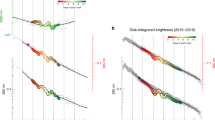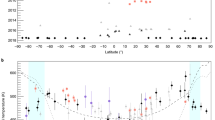Abstract
The 20-µm brightness temperature of the unilluminated (north) side of Saturn's rings is reported here to be 56±1 K. This measurement, together with previous measurements of the rings at 20 µm, shows that the brightness temperature of the B ring can be approximated by the simple equation T4B = 564 + 1.52 × 108 sin |B′|, where B′ is the saturnicentric declination of the Sun. We have assumed that emission from the Cassini division is negligible. The constants in this equation may be understood in terms of a two-component heating model for the ring particles—sunlight and radiation from Saturn. We discuss the implications of the IR data for several published ring models.
This is a preview of subscription content, access via your institution
Access options
Subscribe to this journal
Receive 51 print issues and online access
$199.00 per year
only $3.90 per issue
Buy this article
- Purchase on Springer Link
- Instant access to full article PDF
Prices may be subject to local taxes which are calculated during checkout
Similar content being viewed by others
References
Nolt, I. G. et al. Nature 283, 842 (1980).
Bobrov, M. S. in Surfaces and Interiors of Planets and Satellites (ed. Dollfus, A.) (Academic, New York, 1970).
Ingersoll, A. P., Orton, G. S., Münch, G., Neugebauer, G. & Chase, S. C. Science 207, 439 (1980).
The American Ephemeris and Nautical Almanac (U.S. Naval Observatory, Washington, DC, 1980).
Ferrin, I. R. Icarus 26, 45 (1975).
Fountain, J. W. Bull. Am. astr. Soc. 9, 463 (1977).
Lumme, K. & Reitsema, H. J. Bull. Am. astr. Soc. 9, 463 (1977).
Pollack, J. B. Space Sci. Rev. 18, 3 (1975).
Gehrels, T. et al. Science 207, 434 (1980).
Nolt, I. G., Tokunaga, A., Gillett, F. C. & Caldwell, J. Astrophys. J. Lett. 219, L63 (1978).
Murphy, R. E. in The Rings of Saturn (eds Palluconi, F. D., & Pettengill, G. H.) (NASA SP-343 1974).
Pollack, J. B., Summers, A. & Baldwin, B. Icarus 20, 263 (1973).
Cook, A. F., Franklin, F. A. & Palluconi, F. D. Icarus 18, 317 (1973).
Erickson, E. F., Goorvitch, D., Simpson, J. P. & Strecker, D. W. Icarus 35, 61 (1978).
Kawata, Y. & Irvine, W. M. Icarus 24, 472 (1975).
Murphy, R. E. Astrophys. J. Lett. 181, L87 (1973).
Morrison, D. Icarus 22, 57 (1974).
Rieke, G. H. Icarus 26, 37 (1975).
Sinton, W. M., Macy, W. W., Good, J. & Orton, G. S. Icarus 42, 251 (1980).
Author information
Authors and Affiliations
Rights and permissions
About this article
Cite this article
Tokunaga, A., Caldwell, J. & Nolt, I. The 20-µm brightness temperature of the unilluminated side of Saturn's rings. Nature 287, 212–214 (1980). https://doi.org/10.1038/287212a0
Received:
Accepted:
Issue Date:
DOI: https://doi.org/10.1038/287212a0
This article is cited by
-
Exploring The Saturn System In The Thermal Infrared: The Composite Infrared Spectrometer
Space Science Reviews (2004)
Comments
By submitting a comment you agree to abide by our Terms and Community Guidelines. If you find something abusive or that does not comply with our terms or guidelines please flag it as inappropriate.



